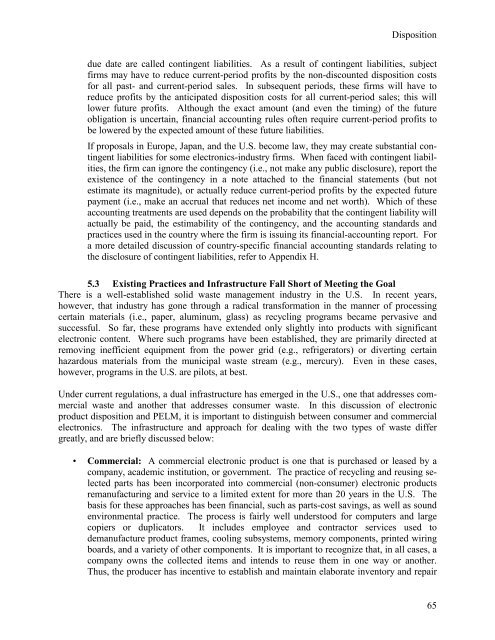1996 Electronics Industry Environmental Roadmap - Civil and ...
1996 Electronics Industry Environmental Roadmap - Civil and ...
1996 Electronics Industry Environmental Roadmap - Civil and ...
Create successful ePaper yourself
Turn your PDF publications into a flip-book with our unique Google optimized e-Paper software.
Disposition<br />
due date are called contingent liabilities. As a result of contingent liabilities, subject<br />
firms may have to reduce current-period profits by the non-discounted disposition costs<br />
for all past- <strong>and</strong> current-period sales. In subsequent periods, these firms will have to<br />
reduce profits by the anticipated disposition costs for all current-period sales; this will<br />
lower future profits. Although the exact amount (<strong>and</strong> even the timing) of the future<br />
obligation is uncertain, financial accounting rules often require current-period profits to<br />
be lowered by the expected amount of these future liabilities.<br />
If proposals in Europe, Japan, <strong>and</strong> the U.S. become law, they may create substantial contingent<br />
liabilities for some electronics-industry firms. When faced with contingent liabilities,<br />
the firm can ignore the contingency (i.e., not make any public disclosure), report the<br />
existence of the contingency in a note attached to the financial statements (but not<br />
estimate its magnitude), or actually reduce current-period profits by the expected future<br />
payment (i.e., make an accrual that reduces net income <strong>and</strong> net worth). Which of these<br />
accounting treatments are used depends on the probability that the contingent liability will<br />
actually be paid, the estimability of the contingency, <strong>and</strong> the accounting st<strong>and</strong>ards <strong>and</strong><br />
practices used in the country where the firm is issuing its financial-accounting report. For<br />
a more detailed discussion of country-specific financial accounting st<strong>and</strong>ards relating to<br />
the disclosure of contingent liabilities, refer to Appendix H.<br />
5.3 Existing Practices <strong>and</strong> Infrastructure Fall Short of Meeting the Goal<br />
There is a well-established solid waste management industry in the U.S. In recent years,<br />
however, that industry has gone through a radical transformation in the manner of processing<br />
certain materials (i.e., paper, aluminum, glass) as recycling programs became pervasive <strong>and</strong><br />
successful. So far, these programs have extended only slightly into products with significant<br />
electronic content. Where such programs have been established, they are primarily directed at<br />
removing inefficient equipment from the power grid (e.g., refrigerators) or diverting certain<br />
hazardous materials from the municipal waste stream (e.g., mercury). Even in these cases,<br />
however, programs in the U.S. are pilots, at best.<br />
Under current regulations, a dual infrastructure has emerged in the U.S., one that addresses commercial<br />
waste <strong>and</strong> another that addresses consumer waste. In this discussion of electronic<br />
product disposition <strong>and</strong> PELM, it is important to distinguish between consumer <strong>and</strong> commercial<br />
electronics. The infrastructure <strong>and</strong> approach for dealing with the two types of waste differ<br />
greatly, <strong>and</strong> are briefly discussed below:<br />
Commercial: A commercial electronic product is one that is purchased or leased by a<br />
company, academic institution, or government. The practice of recycling <strong>and</strong> reusing selected<br />
parts has been incorporated into commercial (non-consumer) electronic products<br />
remanufacturing <strong>and</strong> service to a limited extent for more than 20 years in the U.S. The<br />
basis for these approaches has been financial, such as parts-cost savings, as well as sound<br />
environmental practice. The process is fairly well understood for computers <strong>and</strong> large<br />
copiers or duplicators. It includes employee <strong>and</strong> contractor services used to<br />
demanufacture product frames, cooling subsystems, memory components, printed wiring<br />
boards, <strong>and</strong> a variety of other components. It is important to recognize that, in all cases, a<br />
company owns the collected items <strong>and</strong> intends to reuse them in one way or another.<br />
Thus, the producer has incentive to establish <strong>and</strong> maintain elaborate inventory <strong>and</strong> repair<br />
65






